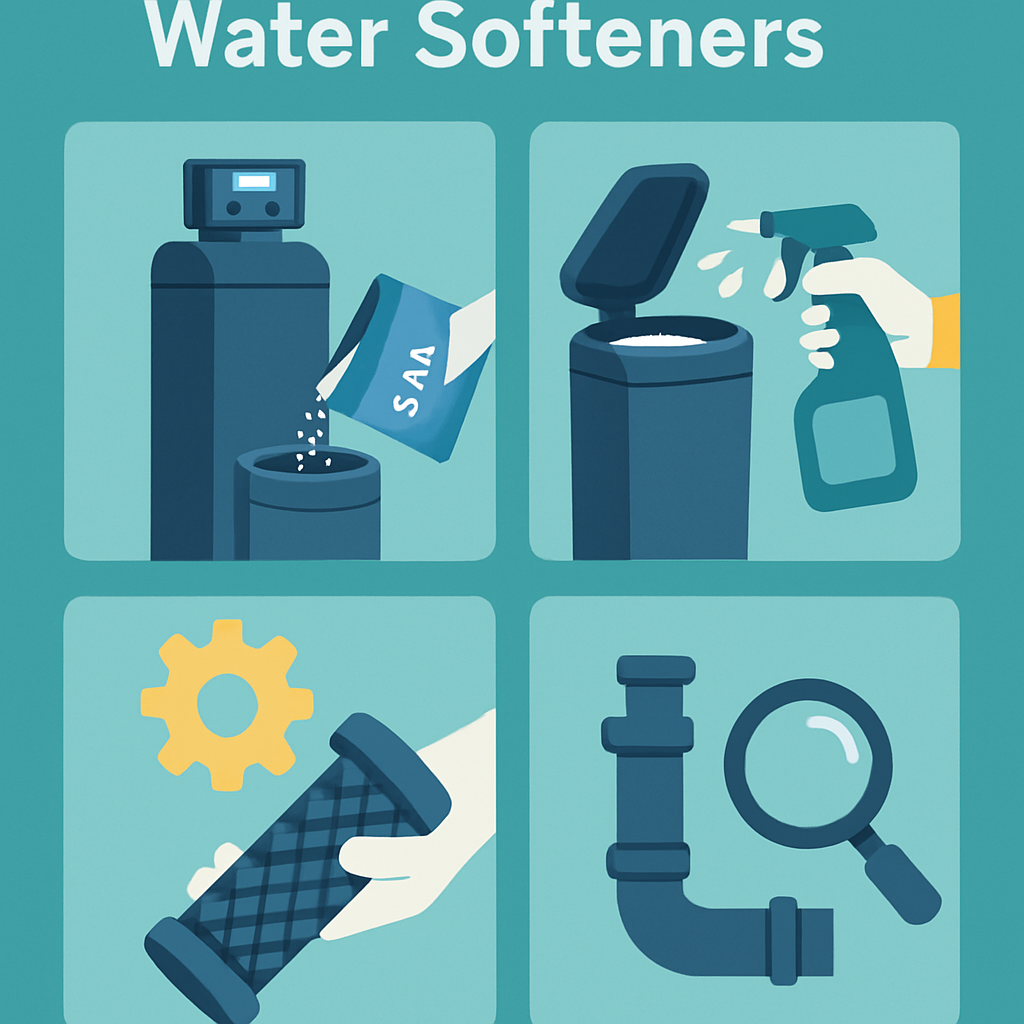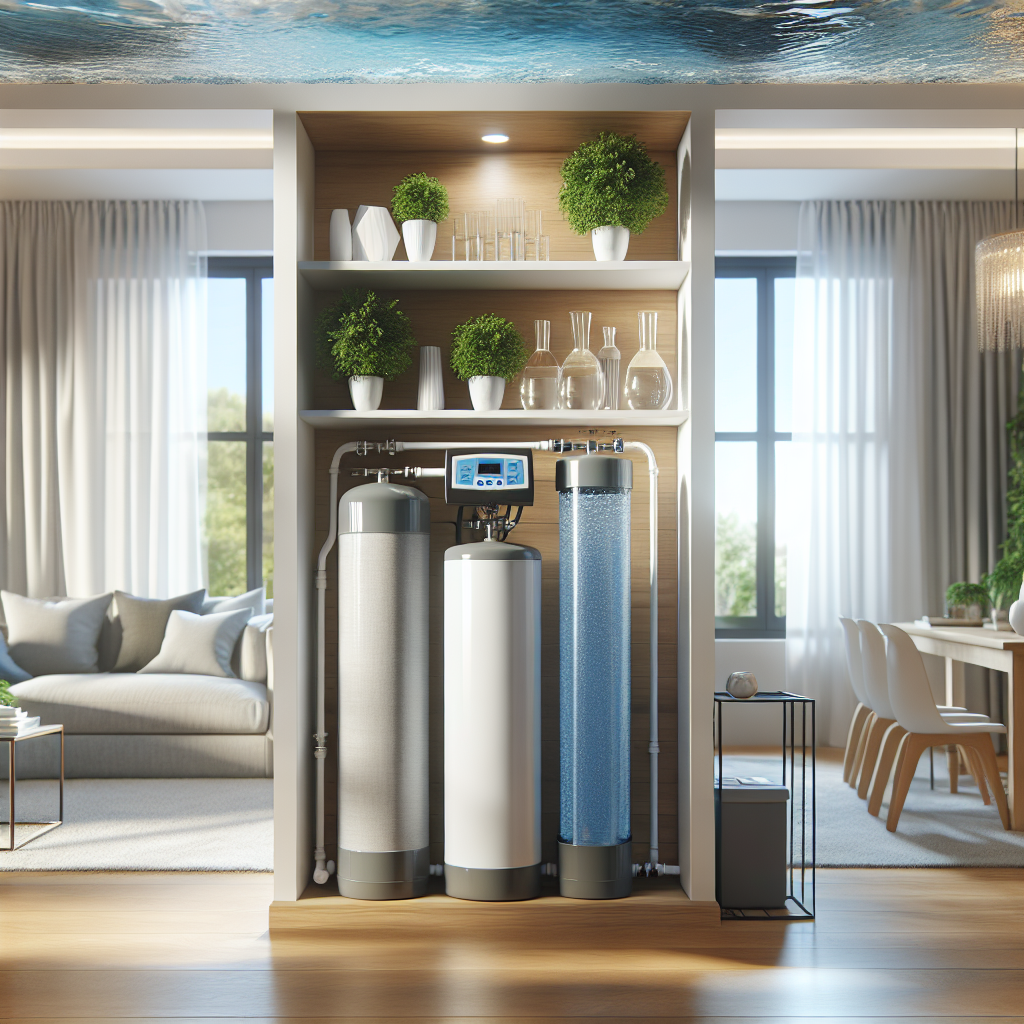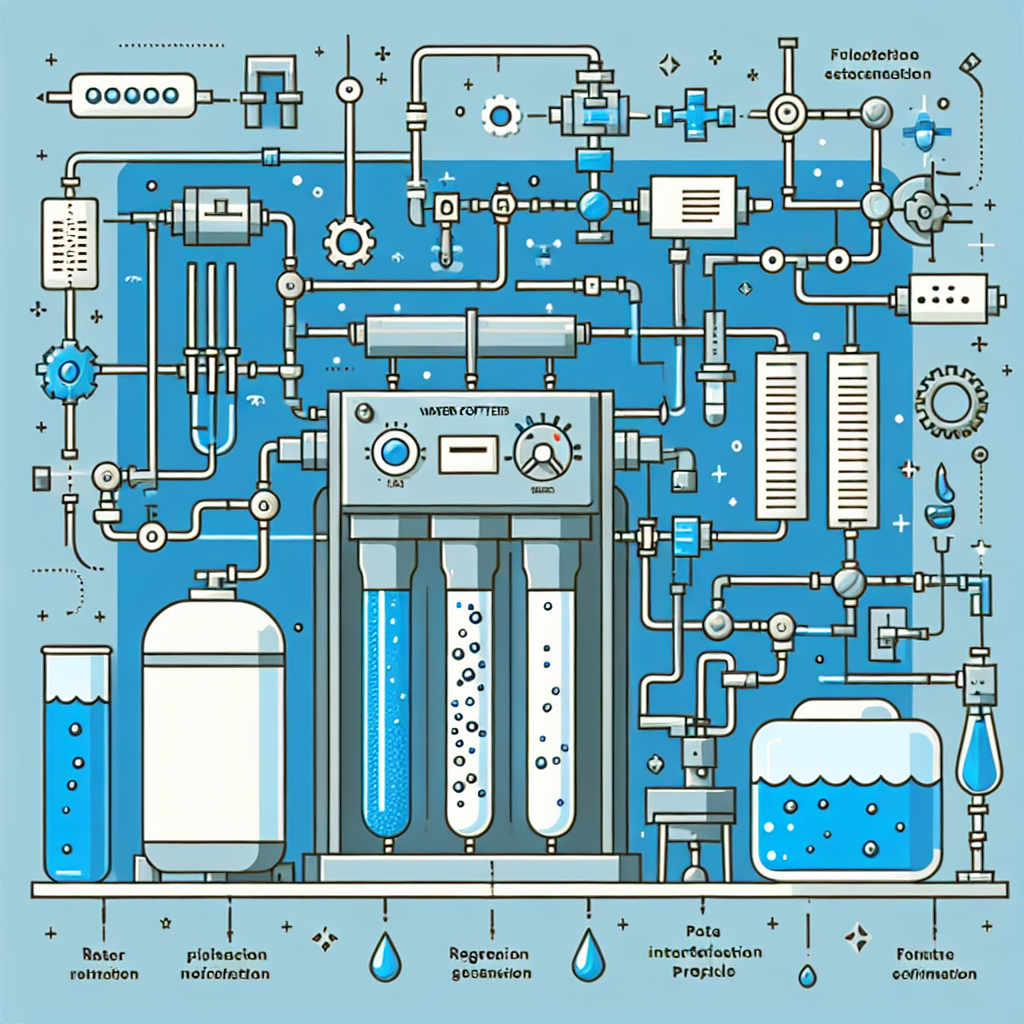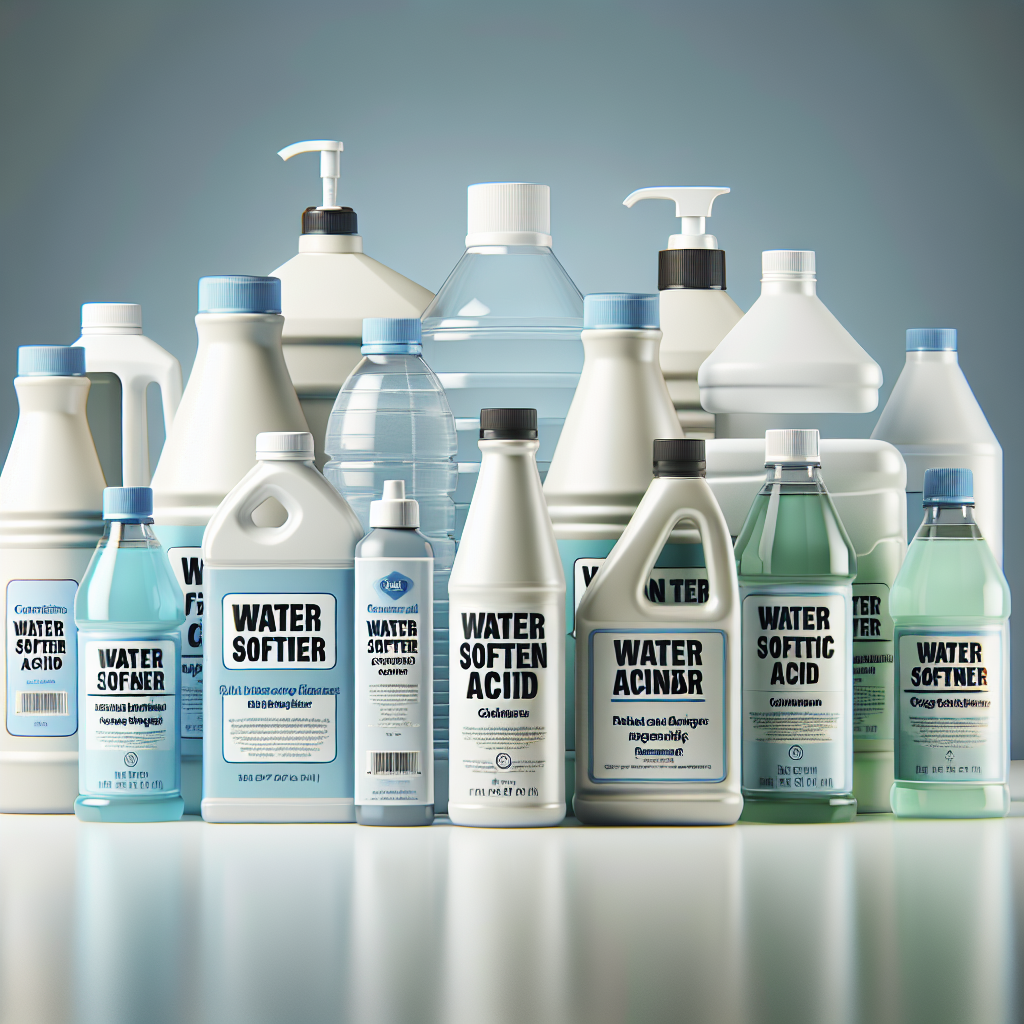
Expert Guide: Maintaining Your Water Softener System

Expert Guide: Maintaining Your Water Softener System
Introduction
Welcome to the world of water softeners, where hard water meets its match! If you’re here, chances are you want to dive into the nitty-gritty of water softener cleaning. This essential maintenance step not only keeps your system running smoothly but also extends its lifespan and ensures your water remains crystal clear and free from pesky mineral buildup.
Think of your water softener as the superhero of your plumbing system. It battles hard water villains like calcium and magnesium, saving your pipes and appliances from their destructive tendencies. But even superheroes need a little TLC now and then! Regular water softener maintenance is crucial to keep this hero in top form.
In this guide, we’ll cover everything from the basics of how to clean a water softener to advanced techniques for tackling stubborn issues like salt bridges. Whether you’re dealing with cleaning water softener resin tanks or figuring out how to flush out a water softener system, we’ve got you covered!
Did you know? Neglecting regular cleaning can lead to decreased efficiency and costly repairs down the line. So let’s roll up our sleeves and get ready for some serious water softener cleaning action!
Understanding Water Softeners
Water softeners are like the superheroes of your plumbing system, swooping in to rescue you from the clutches of hard water. But what exactly is a water softener? In simple terms, it’s a system designed to remove minerals like calcium and magnesium from your water, replacing them with sodium ions. This process is vital for preventing scale buildup in your pipes and appliances.
So, how does a water softener work its magic? It all comes down to a process called ion exchange. When hard water passes through the resin bed inside the softener, the calcium and magnesium ions are exchanged for sodium ions. This not only makes your water softer but also helps extend the lifespan of your plumbing fixtures and appliances.
Benefits of Using a Water Softener
- Better Soap Efficiency: Softened water lathers better with soap, meaning you can use less shampoo and detergent.
- No More Scale Buildup: Say goodbye to those pesky mineral deposits that clog pipes and reduce appliance efficiency!
- Softer Skin and Hair: Enjoy the luxurious feel of softer skin and hair after bathing in softened water.
- Longer Appliance Lifespan: Appliances like dishwashers and washing machines will last longer without the damaging effects of hard water.
- Savings on Energy Bills: Less scale means appliances run more efficiently, saving you money on energy costs.
If you’re wondering about maintenance, don’t fret! Proper water softener cleaning is key to keeping your system running smoothly. Regular checks on components such as the resin tank and brine tank will help you avoid common issues like salt bridges or clogged injectors.
Importance of Water Softener Maintenance
Just like your trusty coffee maker needs a good scrub now and then to keep brewing that perfect cup, your water softener also craves a little TLC. Regular water softener cleaning is essential to ensure it operates at peak efficiency and keeps your water sparkling clean. Let’s dive into why maintenance is not just a nice-to-have but a must-do!
Why Regular Maintenance is Crucial
Think of your water softener as the unsung hero of your home’s plumbing system. It works hard to remove hard minerals like calcium and magnesium, which can wreak havoc on your pipes, appliances, and skin. But without proper maintenance, this hero can become a zero! Here’s why:
- Efficiency: Regular cleaning restores the efficiency of a water softener, ensuring it uses less salt and water during regeneration.
- Longevity: Just like changing the oil in your car can extend its life, routine maintenance helps prolong the lifespan of your water softener.
- Avoiding Costly Repairs: Neglecting maintenance can lead to major issues such as clogged injectors or resin bed problems, which can be expensive to fix.
Potential Issues from Neglecting Maintenance
If you think skipping maintenance is harmless, think again! Here are some potential pitfalls:
- Silt and Sediment Buildup: Over time, sediment can accumulate in the brine tank, leading to reduced performance. Think of it as your water softener trying to swim through molasses!
- Salt Bridges: A salt bridge forms when salt crystals harden into a solid mass in the brine tank, preventing effective regeneration. It’s like trying to break through a wall made of ice with a spoon!
- Ineffective Softening: If you don’t clean the resin bed regularly, you might find yourself battling hard water stains again talk about going backward!
Key Takeaway: Regular maintenance not only enhances performance but also prevents annoying hiccups down the line. So roll up those sleeves and get ready for some DIY fun!
Water Softener Cleaning Techniques
Keeping your water softener clean is like giving it a spa day essential for maintaining its health and efficiency! Regular water softener cleaning not only enhances the performance of your system but also extends its lifespan. Here’s how to pamper your water softener with some effective cleaning techniques.
How to Clean a Water Softener
Cleaning a water softener isn’t rocket science, but it does require a bit of know-how. Start by turning off the system and disconnecting the power. Then, follow these steps:
- Flush out the system by running a regeneration cycle.
- Add a cleaning solution like a citric acid water softener cleaner or even vinegar to the brine tank.
- Let it sit for about 15-30 minutes, allowing the cleaner to work its magic.
- Run another regeneration cycle to rinse everything out.
Cleaning the Resin Tank
The resin tank is where all the action happens, so keeping it clean is crucial. To clean your resin tank:
- Disconnect the brine line and drain any excess water.
- Add a resin cleaner specifically designed for water softeners; this will help remove iron and other contaminants.
- Run a regeneration cycle to flush out debris.
Brine Tank Cleaning Procedures
Your brine tank is like the heart of your water softening system. Here’s how to keep it pumping smoothly:
- Remove any salt buildup by breaking up large chunks this is where salt bridges can form!
- Scoop out any sediment that has settled at the bottom of the tank.
- If you see any residue, mix a bleach solution (1 part bleach to 10 parts water) and scrub down the interior surfaces. Rinse thoroughly!
Salt Bridge Removal Methods
A salt bridge can be as pesky as that one friend who never leaves your couch! To remove it:
- Poke around with a broom handle or similar tool to break up the salt bridge gently.
- Add warm water to help dissolve any remaining salt clumps.
- Once broken up, ensure you run a complete regeneration cycle to clear everything out!
Pro Tip: Always check manufacturer guidelines for specific cleaning instructions tailored to your model. This ensures you’re using compatible products and methods!
Water Softener Regeneration Process
Ah, the regeneration process it’s like the spa day for your water softener! This is where all the magic happens to keep your system running smoothly and efficiently. But what does it really entail? Let’s dive in.
Understanding Regeneration Cycles
The regeneration cycle is a crucial part of water softener cleaning. It’s basically a reset for your system, allowing it to flush out accumulated minerals and recharge the resin beads that do all the heavy lifting. Think of it as a refreshing cleanse after a long week of hard work!
- Ion Exchange: During regeneration, sodium ions replace calcium and magnesium ions that have built up in the resin bed.
- Backwashing: This process reverses the flow of water to remove debris and sediment from the resin bed.
- Rinsing: After backwashing, a rinse cycle ensures that any leftover brine is washed away before the system goes back to softening water.
Frequency of Regeneration for Optimal Performance
The frequency of these regeneration cycles can vary based on your water usage and hardness levels. It’s like finding that sweet spot between too much pampering and not enough!
- Regular Usage: If you have a larger household or high water usage, you may need to regenerate every few days.
- Low Usage: For smaller households or less frequent use, once a week might suffice.
- Hard Water Levels: Higher hardness levels require more frequent regenerations to maintain efficiency.
Takeaway: Regularly monitoring your regeneration cycles not only enhances performance but also extends the lifespan of your water softener. Don’t skip this step!
Tips for Effective Regeneration
If you’re looking to optimize your water softener maintenance further, here are some pro tips:
- Add salt regularly to prevent salt bridges nobody wants their brine tank turning into a salt sculpture!
- If you notice reduced performance, consider descaling your system using citric acid or other recommended cleaners.
- Avoid using vinegar as it can damage certain components; stick with approved products for cleaning water softeners.
Troubleshooting Common Issues
Even the best water softener systems can run into hiccups now and then. Think of it as your water softener having a bad hair day no biggie! With a little troubleshooting, you can restore its smooth, silky function in no time. Here’s how to tackle some common issues:
Identifying Signs of Malfunctioning Systems
First things first: how do you know if your water softener is throwing a tantrum? Look out for these telltale signs:
- Hard water stains on fixtures and dishes.
- Sudden increase in soap usage like you’re in a bubble bath commercial.
- Low water pressure or flow issues.
- Unpleasant taste or odor in your water.
Troubleshooting Clogged Injectors and Venturi Valves
If you suspect that your water softener is not regenerating properly, it might be time to check the injectors and venturi valves. These components can easily get clogged with debris or mineral buildup, causing all sorts of trouble. Here’s what to do:
- Turn off the system and disconnect it from power.
- Remove the injector and inspect for clogs think of it as giving your softener a dental check-up!
- If clogged, soak it in a citric acid solution or use a specialized resin cleaner for water softeners to dislodge any stubborn gunk.
- Reassemble everything once it’s clean, and give it another go!
Addressing Salt Buildup Problems
No one wants their brine tank looking like an ice sculpture made of salt! If you notice salt buildup or crusty layers forming inside the tank, here’s how to tackle that:
- Inspect the brine tank regularly, especially during high-demand seasons.
- If you spot a salt bridge (a solid mass of salt), gently break it up with a broom handle or similar tool.
- For persistent buildup, consider using iron out for water softeners to clear away any stubborn deposits.
- Regularly flush out the brine tank by draining it completely and cleaning with warm soapy water don’t forget to rinse thoroughly!
If you find yourself facing more complex problems that require professional attention, don’t hesitate to call in an expert. Your goal is to restore efficiency to your system without losing your sanity or your hard-earned money!
Cleansing Agents and Solutions for Water Softeners
When it comes to water softener cleaning, choosing the right cleansing agents is crucial. Think of it as picking the right shampoo for your hair certain formulas work better depending on your hair type, and the same goes for your water softening system!
Citric Acid: The Natural Powerhouse
Citric acid is gaining popularity as a go-to cleaner for water softeners. It’s like the Swiss Army knife of cleaning agents effective, versatile, and natural! Using citric acid can help:
- Remove mineral buildup.
- Restore efficiency in the resin bed.
- Keep your system running smoothly without harsh chemicals.
The Role of Vinegar in Cleaning Processes
Ah, vinegar the trusty sidekick in many households! While you might think of it as just a salad dressing, it’s also a great option for cleaning water softeners. Here’s how vinegar can help:
- Acts as a mild acid to dissolve scale.
- Helps in flushing out sediment from the brine tank.
- Can be used to sanitize components when mixed with water.
The Best Water Softener Cleaners Available
If DIY isn’t your style, fear not! There are plenty of commercial options that can do the job just right. Here are some top contenders:
| Cleaner | Main Benefits |
|---|---|
| Citra-Flush | Great for descaling and removing iron build-up. |
| Iron Out | Specifically designed to tackle iron stains in water softeners. |
| Resin Cleaner | A specialized formula that cleans and rejuvenates resin beds. |
So there you have it a quick guide to effective cleansing agents for maintaining your water softener. Whether you opt for natural solutions like citric acid and vinegar or stick with trusted commercial products, keeping your system clean is key to smooth sailing (or should we say, smooth flowing?)!
Routine Maintenance Tips for Optimal Performance
Just like a well-oiled machine, your water softener needs a little TLC to keep it running smoothly. Think of it as giving your favorite car a regular wash and tune-up it’s all about maintaining that shiny, efficient performance. Here are some essential tips to ensure your water softener stays in top-notch shape:
- Inspecting and Cleaning Components Regularly: Make it a habit to check the components of your water softener every few months. Look for any signs of wear and tear, leaks, or clogs. A quick visual inspection can save you from bigger headaches down the road.
- Best Practices for Resin Bed Cleaning: The resin bed is like the sponge of your water softener it absorbs all those hard minerals. To keep it working efficiently, consider using a resin cleaner for water softeners. This will help restore its efficiency and prolong its life. Remember, cleaning the resin bed isn’t just about aesthetics; it’s crucial for optimal performance!
- Sanitizing the System with Bleach Solutions: Every now and then, give your system a thorough sanitization. Mix a bleach solution (typically 1 cup of bleach in a gallon of water) and run it through the system to eliminate bacteria and other nasties that could be lurking around.
- Preventative Measures to Avoid Sediment Buildup in Brine Tank: Sediment buildup can be a sneaky culprit behind poor water quality. To combat this, regularly flush out the brine tank by removing any accumulated sludge at the bottom. This simple task will help keep your system running efficiently.
- Regular Salt Bridge Removal: A salt bridge can form when salt crystals harden into a solid mass above the brine solution. This can prevent proper regeneration. If you suspect you have one (and you might if you notice salty taste or reduced efficiency), break it up gently with a broom handle or similar tool.
- Flush Out Water Softener System: Periodically flushing out your system helps remove any lingering minerals or contaminants that could affect performance. Follow manufacturer guidelines on how often this should be done typically every few months is ideal.
- Cleansing Agents: Use Wisely! When selecting cleansing agents like citric acid or vinegar in your cleaning regimen, make sure they’re compatible with your specific model. Some systems may react poorly to certain chemicals, so always check before diving in!
Pro Tip: Always refer to your user manual for specific maintenance schedules and recommendations tailored to your water softener model!
If you follow these routine maintenance tips for optimal performance, you’ll not only extend the life of your water softener but also enjoy cleaner and softer water day in and day out! So roll up those sleeves and get ready to pamper your trusty water-softening sidekick!
Conclusion
- < li >Inspecting and cleaning components regularly
- Best practices for resin bed cleaning
- Sanitizing the system with bleach solutions
- Preventative measures to avoid sediment buildup in brine tank ul> section >
< h2 >Conclusion h2 > section >



